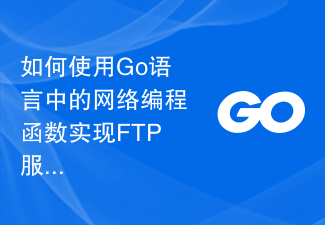 Backend Development
Backend Development Golang
Golang Learn network programming functions in Go language and implement a WebSocket server chat room?
Learn network programming functions in Go language and implement a WebSocket server chat room?Learn network programming functions in Go language and implement WebSocket server chat rooms
Introduction
With the rapid development of the Internet, Web applications have become an indispensable part of people's lives. Achieving real-time communication is one of the important components of Web applications. WebSocket is a protocol that provides two-way communication and can establish a persistent connection between the browser and the server. This article will introduce how to use the network programming functions in the Go language and combine it with the WebSocket protocol to implement a simple chat room server.
Preparation
Before you start writing code, you need to install the Go language development environment and understand the basic syntax of Go. In addition, we also need to use an open source WebSocket library to simplify the processing of the WebSocket protocol. The library can be installed through the following command:
go get github.com/gorilla/websocket
Code implementation
First, we need to import the necessary packages:
package main
import (
"fmt"
"log"
"net/http"
"github.com/gorilla/websocket"
)Next, define the upgrader for the WebSocket connection. The upgrader is a http.HandlerFunc, which upgrades the HTTP connection to a WebSocket connection:
var upgrader = websocket.Upgrader{
ReadBufferSize: 1024,
WriteBufferSize: 1024,
CheckOrigin: func(r *http.Request) bool {
return true
},
}Then, define a structure to represent the chat room server:
type ChatRoom struct {
clients map[*websocket.Conn]bool
broadcast chan []byte
}
func newChatRoom() *ChatRoom {
return &ChatRoom{
clients: make(map[*websocket.Conn]bool),
broadcast: make(chan []byte),
}
}Next, implement the chat room server Methods. The first is the handleWebSocket function, which is used to handle the upgrade of WebSocket connections and message processing:
func (c *ChatRoom) handleWebSocket(w http.ResponseWriter, r *http.Request) {
conn, err := upgrader.Upgrade(w, r, nil)
if err != nil {
log.Println(err)
return
}
c.clients[conn] = true
for {
_, msg, err := conn.ReadMessage()
if err != nil {
log.Println(err)
delete(c.clients, conn)
break
}
c.broadcast <- msg
}
defer conn.Close()
}Then, implement the broadcastMessage function, which is used to broadcast messages to all connected clients:
func (c *ChatRoom) broadcastMessage() {
for {
msg := <-c.broadcast
for client := range c.clients {
err := client.WriteMessage(websocket.TextMessage, msg)
if err != nil {
log.Println(err)
client.Close()
delete(c.clients, client)
}
}
}
}Finally , implement the main function, used to start the chat room server:
func main() {
room := newChatRoom()
go room.broadcastMessage()
http.HandleFunc("/ws", room.handleWebSocket)
err := http.ListenAndServe(":8080", nil)
if err != nil {
log.Fatal(err)
}
}Run
Run the following command in the code directory to start the chat room server:
go run main.go
Then access http in the browser: //localhost:8080, open the browser's developer tools, switch the console to the WebSocket tab, use the following JavaScript code to connect to the server:
var socket = new WebSocket("ws://localhost:8080/ws");
socket.onopen = function(event) {
console.log("Connected to the server");
};
socket.onmessage = function(event) {
console.log("Received message: " + event.data);
};
socket.onclose = function(event) {
console.log("Disconnected from the server");
};
socket.send("Hello, server!");Now, you can do this between the browser and the server Real-time two-way communication.
Summary
By learning the network programming functions in Go language and combining with the WebSocket protocol, we implemented a simple chat room server. WebSocket can establish a persistent connection between the browser and the server to achieve real-time communication. With the help of Golang's network programming functions, we can easily handle WebSocket connections and message transmission. I hope this article can help you learn network programming and WebSocket in Go language.
The above is the detailed content of Learn network programming functions in Go language and implement a WebSocket server chat room?. For more information, please follow other related articles on the PHP Chinese website!
 零基础学习Go语言:环境配置不再成为障碍Feb 21, 2024 pm 02:12 PM
零基础学习Go语言:环境配置不再成为障碍Feb 21, 2024 pm 02:12 PMGo语言是一种由Google开发的静态类型、编译型的编程语言。它在现代编程语言中拥有独特的地位,被广泛应用于云计算、网络编程、大数据等领域。随着Go语言的逐渐流行,越来越多的程序员开始学习Go语言,希望能够掌握这门语言的特性和应用技巧。然而,对于零基础的学习者来说,Go语言的环境配置常常成为他们学习的第一个障碍。在学习Go语言之前,我们首先需要搭建一个适合的
 学习Go语言的第一步:数据库连接与操作的实现方法Jan 23, 2024 am 08:10 AM
学习Go语言的第一步:数据库连接与操作的实现方法Jan 23, 2024 am 08:10 AM从零开始学习Go语言:如何实现数据库连接与操作,需要具体代码示例1、简介Go语言是一种开源的编程语言,由Google开发,并广泛用于构建高性能、可靠性强的服务器端软件。在Go语言中,使用数据库是非常常见的需求,本文将介绍如何在Go语言中实现数据库的连接与操作,并给出具体的代码示例。2、选择合适的数据库驱动在Go语言中,有许多第三方数据库驱动可以选择,比如My
 从零开始学习Go语言图形API开发Mar 24, 2024 am 08:00 AM
从零开始学习Go语言图形API开发Mar 24, 2024 am 08:00 AM从零开始学习Go语言图形API开发,需要具体代码示例图形API开发一直以来都是程序员们感兴趣的领域之一。通过图形API开发,我们可以创建出各种各样的图形界面应用程序,使用户可以更加直观地与软件进行交互。而Go语言作为一门高效、简洁、并发的编程语言,越来越受到开发者的青睐。那么,如何从零开始学习Go语言图形API开发呢?本文将介绍一些基础知识,并提供具体的代码
 如何使用Go语言中的网络编程函数实现UDP通信?Jul 30, 2023 am 10:22 AM
如何使用Go语言中的网络编程函数实现UDP通信?Jul 30, 2023 am 10:22 AM如何使用Go语言中的网络编程函数实现UDP通信?在网络编程中,UDP(UserDatagramProtocol,用户数据报协议)是一种无连接、不可靠的传输协议,适用于一对一或一对多的简单数据传输场景。Go语言作为一种现代化、高效率的编程语言,提供了丰富的网络编程函数,可以轻松实现UDP通信。首先,我们需要导入net包,以便使用其中的网络编程函数。接下来,
 如何使用Go语言中的网络编程函数实现FTP服务器下载文件?Jul 31, 2023 pm 12:05 PM
如何使用Go语言中的网络编程函数实现FTP服务器下载文件?Jul 31, 2023 pm 12:05 PM如何使用Go语言中的网络编程函数实现FTP服务器下载文件?FTP(FileTransferProtocol,文件传输协议)是一种用于在网络上进行文件传输的标准协议。在实际开发中,我们常常会遇到需要从FTP服务器上下载文件的情况。使用Go语言中的网络编程函数,我们可以轻松地实现FTP服务器的文件下载功能。本文将介绍如何使用Go语言实现FTP服务器文件下载,
 从零开始学习Go语言中16进制转二进制Mar 16, 2024 am 11:48 AM
从零开始学习Go语言中16进制转二进制Mar 16, 2024 am 11:48 AM标题:从零开始学习Go语言中16进制转二进制在学习编程语言的过程中,对于数据类型的转换是至关重要的一部分。在Go语言中,16进制转换成二进制是一种常见的操作。本文将从零开始,通过具体的代码示例,带领读者学习如何在Go语言中进行16进制到二进制的转换。首先,我们来了解一下16进制和二进制的基本概念。在计算机中,二进制是一种由0和1组成的数制,而16进制是由0-
 从零开始学习Go语言中fn的基础知识Mar 27, 2024 pm 02:18 PM
从零开始学习Go语言中fn的基础知识Mar 27, 2024 pm 02:18 PM从零开始学习Go语言中函数(fn)的基础知识随着Go语言在近年来在编程领域的热度不断上升,越来越多的开发者开始学习和使用Go语言。在学习Go语言的过程中,函数(fn)是一个非常重要且基础的概念,掌握函数的基础知识对于深入学习Go语言非常重要。本文将从零开始介绍Go语言中函数的基础知识,并附上具体的代码示例,帮助初学者快速掌握这一知识点。首先,我们需要了解函
 学习Go语言的测试和性能优化方法Nov 30, 2023 am 10:36 AM
学习Go语言的测试和性能优化方法Nov 30, 2023 am 10:36 AM学习Go语言的测试和性能优化方法Go语言是一种开源的编程语言,以其简洁、高效和并发性能著称。随着Go语言在云计算、网络服务和大数据领域的广泛应用,对于Go语言测试和性能优化的需求也与日俱增。本文将介绍学习Go语言的测试和性能优化方法,帮助读者更好地理解和使用Go语言。一、测试方法单元测试:单元测试是指对程序中的某个最小模块进行测试,以验证其功能是否符合预期。


Hot AI Tools

Undresser.AI Undress
AI-powered app for creating realistic nude photos

AI Clothes Remover
Online AI tool for removing clothes from photos.

Undress AI Tool
Undress images for free

Clothoff.io
AI clothes remover

AI Hentai Generator
Generate AI Hentai for free.

Hot Article

Hot Tools

ZendStudio 13.5.1 Mac
Powerful PHP integrated development environment

SAP NetWeaver Server Adapter for Eclipse
Integrate Eclipse with SAP NetWeaver application server.

EditPlus Chinese cracked version
Small size, syntax highlighting, does not support code prompt function

DVWA
Damn Vulnerable Web App (DVWA) is a PHP/MySQL web application that is very vulnerable. Its main goals are to be an aid for security professionals to test their skills and tools in a legal environment, to help web developers better understand the process of securing web applications, and to help teachers/students teach/learn in a classroom environment Web application security. The goal of DVWA is to practice some of the most common web vulnerabilities through a simple and straightforward interface, with varying degrees of difficulty. Please note that this software

Atom editor mac version download
The most popular open source editor





